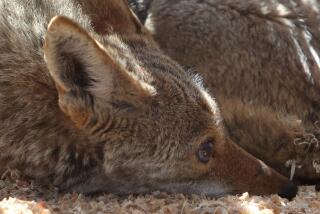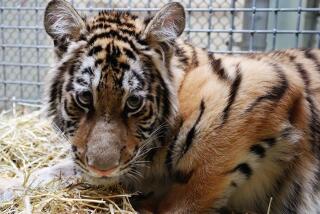Americans are going gaga over the bears. Visit them at four U.S. zoos.
Washington, D.C.
The capital’s most popular family lounges in trees and eats shoots and leaves. And the threesome seems happy to show off its new digs to the 2 million tourists who will visit in the coming year. In California, another well-liked vegetarian family has a newborn to share with the 3.2 million visitors who drop by there annually.
The giant pandas of the Smithsonian National Zoological Park in Washington, D.C. -- and those of the San Diego Zoo -- are a hot ticket. The endangered bears, indigenous to China, have become so admired by Americans that there are fan clubs, panda cams enabling viewers to watch from home and hundreds of products such as T-shirts, clocks, mugs and mouse pads.
At the National Zoo, the roly-poly-looking mammals have been one of the capital’s biggest tourist draws since two pandas took up residence in 2000. After the birth of cub Tai Shan in 2005, interest mushroomed. Now, the three are spending their first summer in an expanded habitat.
On the West Coast, the San Diego Zoo’s four pandas recently welcomed a fifth member into their clan -- a baby born Aug. 3.
And there’s more news in Pandaland USA. In Atlanta, the zoo is getting ready for a big celebration to mark cub Mei Lan’s first birthday on Sept. 6. But the news from the zoo in Memphis, Tenn., is not happy: Ya Ya didn’t carry her first baby to term.
To panda fans, it’s all part of the day-to-day drama. “We relate to them because in some ways, they’re very much like humans,” said Maryland resident Frances Nguyen, who founded Pandas Unlimited, an international group that celebrates the bears at www.flickr.com/groups/pandasunlimited. “The way the mothers sacrifice for the babies, the way they bond. In other ways, they seem like living teddy bears. Everything about them is fascinating.”
The expanded panda home at the National Zoo is part of a new exhibit, the Fujifilm Giant Panda Habitat & Asia Trail, that opened late last year. The exhibit, covering nearly 6 acres, is the most significant improvement at the National Zoo in nearly 40 years and the first major project completed in a 10-year revitalization plan. “Our goal is to be the world’s finest zoo by 2016,” said its director, John Berry.
The stars, of course, are the pandas, but they have some new neighbors: clouded leopards, sloth bears, fishing cats, red pandas, a Japanese giant salamander and Asian small-clawed otters.
Visitors to the $53-million project wander the perimeter of the panda habitat, where they’re likely to catch the creatures munching on bamboo or sleeping in a tree.
The pandas helped design the habitat themselves, say zookeepers, who kept a list of the things the animals liked best in their original home -- places they enjoyed playing, eating, sleeping and cooling off. Water ranked high, so their new home includes a waterfall, pools and a shallow stream.
The San Diego Zoo has been a center of panda-mania since China allowed two to visit in 1987. After years of red tape, the zoo received a 12-year research loan of two pandas. A new exhibit area was built, and has since been expanded and renovated and is now called the Giant Panda Research Station.
One of the original pandas, Bai Yun, has been busy since coming to the U.S.; the new cub is her fourth, all born at the San Diego Zoo. (At birth, a panda cub weighs about 4 ounces, about the same as a stick of butter.) Although the cub will not be visible outside the den until it is a few months older, it can be viewed with its mother 24 hours a day through the zoo’s panda cam at www.sandiegozoo.org.
Another one of Bai Yun’s cubs, Mei Sheng, born in 2003, is expected to be sent to China in October. He will live there as part of an international collaboration to save the species, which numbers about 1,600 worldwide.
The U.S. pandas are of such great interest to Pandas Unlimited that members keep track of them through blogs and panda cams. At the National Zoo, they take turns standing watch during zoo hours.
“It’s a peaceful, beautiful place,” said Nguyen, the club’s founder. “The pandas are so cute. They always make you laugh.”
rosemary.mcclure@latimes.com
More to Read
Sign up for The Wild
We’ll help you find the best places to hike, bike and run, as well as the perfect silent spots for meditation and yoga.
You may occasionally receive promotional content from the Los Angeles Times.






